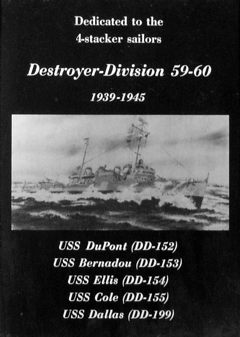
In the Pacific, the first destroyers to carry echo-ranging equipment were DesDiv 19’s Rathburne, Waters, Talbot and Dent while graduates of the first sonar class at New London were assigned to destroyers Du Pont, Bernadou, Ellis and Cole.

Memorial Wall plaque
National Museum of the Pacific War,
Fredericksburg, Texas.
In the spring of 1941, Atlantic Fleet (DesLant) destroyers were engaged in “short-of-war” operations. On 1 March, in preparing for convoy escort duties, the Navy organized a Northeastern Escort Support Force of destroyers, aircraft and support vessels. Three squadrons of destroyers were assigned: DesRon 7, made up entirely of Benson- and Gleaves-class destroyers, and DesRons 30 and 31, all flush deckers.
On 27 May, the same day that British forces sank battleship Bismarck, President Roosevelt declared an “Unlimited National Emergency” and extended the patrol into North and South Atlantic waters. On 15 July, bleak Argentia, Newfoundland was commissioned as base for the Support Force, from which patrols ranged as far east as 30 W.
On 1 July, the first American Naval Task Force organized for foreign service stood out from Argentia, escorting Marines to relieve the British garrison in Iceland. Leading the way in the outer screen were DesDiv 60’s Ellis, Bernadou, Upshur and Lea, with Sims-class Buck.
Following the United States’ entry into World War II at the end of the year, DesRon 30 destroyers continued operations in the Atlantic. Later in the year, Bernadou, Cole and Dallas were modified for special operations during the invasion of North Africa in November 1942. All three survived, and received the Presidential Unit Citation for their actions.